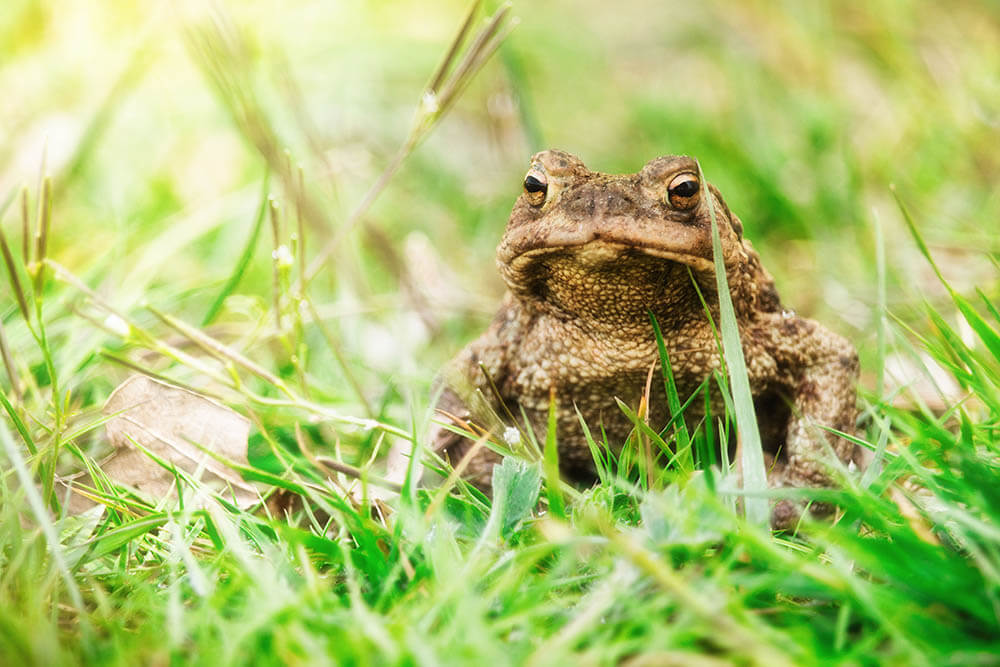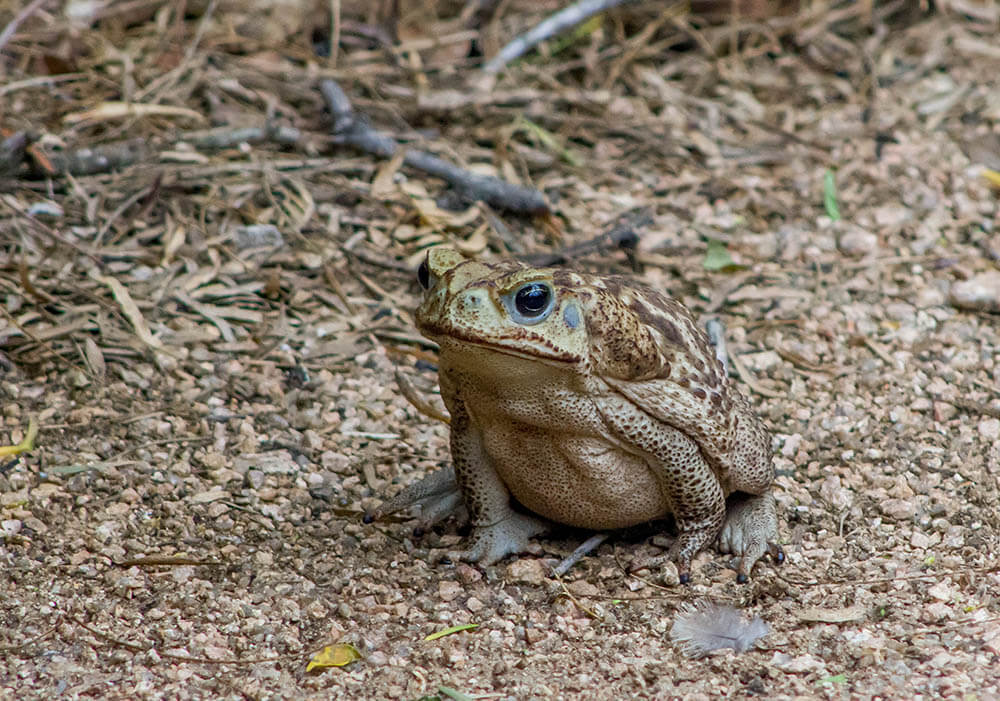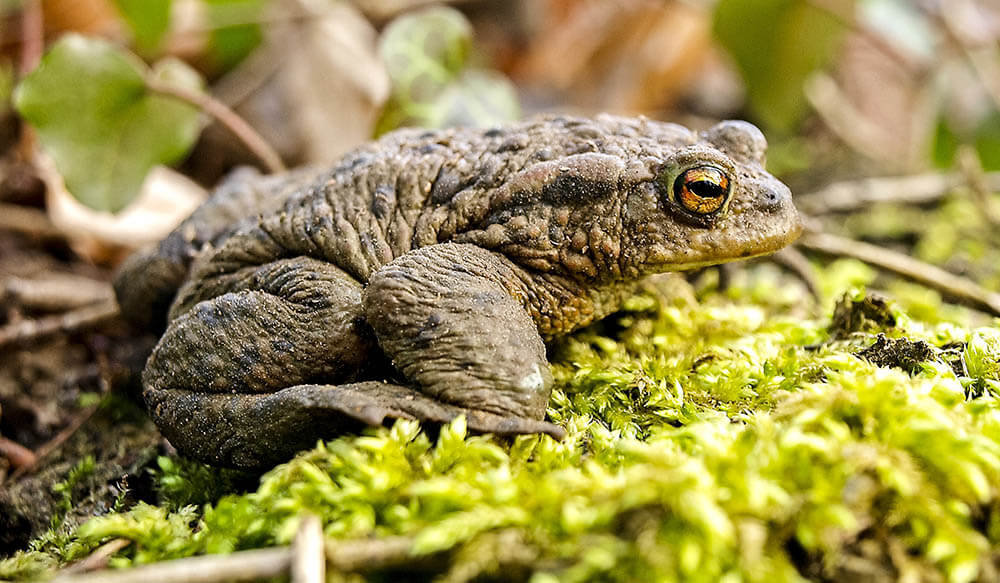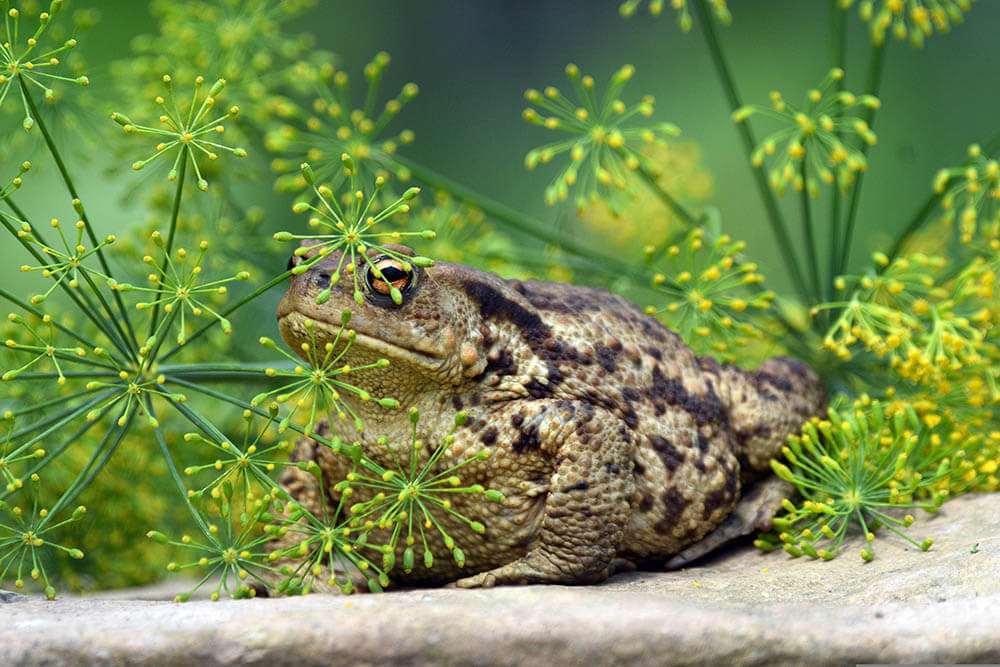While people generally find toads icky, animal enthusiasts are a special sort who see these amphibians as the amazing creatures that they are.
And if you’re one of those who loves animals, then you’ve probably wondered what it’s like to own a pet toad. How would you take care of it? Do you need to give it regular baths? Take it out for walks?
Most importantly, what should you feed a toad?
In today’s article, we’ll be exploring what toads enjoy chowing down on. Before we get to that, however, it’s a good idea to get to know these enigmatic creatures a little better. So keep reading!

Introducing… the Toad!
A toad is an amphibian with a squat, tailless body; crests behind its eyes; and rough, dry skin riddled with warts. It also has parotoid glands that secrete a poisonous substance called bufotoxin, which can harm or even kill small animals – including cats and dogs!
There are thousands of different toad species in the world. They range in size from 1.3 inches (oak toad) to 6 inches long (cane toad), though the largest toad in the world was measured at a whopping 9 inches long!
Toads inhabit every continent except for Antarctica. Adult toads live on land, usually preferring open habitats such as grasslands and fields. They can often be found close to water sources, however. Given their choice of habitat, these animals have adopted a terrestrial diet.
Speaking of diet, it’s time we talked about what toads enjoy putting in their belly!

What Do Toads Eat in the Wild?
Wild toads are voracious and opportunistic eaters; if they see something that looks yummy nearby, they’ll catch and consume it.
What a wild toad feeds on depends on where it lives and food availability. Its diet also changes depending on its age, with newly hatched toads, known as tadpoles or polliwogs, having a vastly different diet than an adult toad.
Below, we list the foods wild toads eat categorized according to the age of the toad.
What tadpoles eat in the wild
Once a tadpole emerges from its egg, the first thing it consumes is the yolk remaining from said egg, which is rich in nutrients that hatchlings require for healthy growth.
Not long afterward, the tadpole begins an herbivorous diet consisting of:
- Algae
As the tadpole grows older, it’ll also start feeding on other types of soft plant matter, such as:
- Duckweed
- Lily pads
- Moss
- Roots/leaves of aquatic plants
The older the tadpole grows, the more omnivorous it becomes; though it still prefers vegetation, it becomes capable of eating small creatures such as:
- Mosquito larvae
- Redworms
In the case of extreme food scarcity, tadpoles may even devour each other.
What juvenile toads eat in the wild
After around 2 months, tadpoles emerge from the water to go on land. By then, they have a full set of legs and resemble a miniature version of an adult toad.
The juvenile toad, or toadlet, observes a carnivorous diet that isn’t too different from an adult toad’s. The main difference is that, given the toadlet’s smaller size, its prey is usually tinier and easier to catch and kill. For this reason, it often prefers small invertebrates.
Here are some examples of the foods toadlets consume:
- Ants
- Flies
- Fruit flies
- Mosquitoes
- Moths
- Pinhead crickets
What adult toads eat in the wild
Unlike their younger selves, adult toads are carnivores, meaning they eat meat and only meat. Despite their lack of teeth, they devour a broad array of prey – and the larger the toad, the bigger its menu. Did we also mention that toads usually prefer their prey alive and kicking?
On average, toads grow up to 4 or 5 inches long. Typically, they hunt down and kill animals that are smaller than them.
Toads enjoy eating insects, arachnids, and other types of bugs such as:
- Ants
- Bees
- Butterflies
- Centipedes
- Crickets
- Flies
- Fruit flies
- Grasshoppers
- Grubs/larvae
- Locusts
- Mealworms
- Mosquitos
- Moths
- Spiders
- Weevils
They love consuming worms like:
- Earthworms
- Super worms
- Wax worms
They ingest their fellow reptiles, including:
- Frogs
- Lizards
- Snakes
- Tadpoles
- Toads
Toads also go after gastropods such as:
- Slugs
- Snails
They even chow down on rodents, including:
- Mice
- Rats
Lastly, toads also eat aquatic creatures like:
- Fish (alive or dead)
As an ambush predator, the toad burrows into the soil and waits for prey to come within striking distance. It then lashes out its long tongue, snatching its victim up so quickly it doesn’t have the chance to react.
The length of a toad’s tongue depends on its species. Many toads, however, have tongues that are nearly twice the length of their body.
Due to their lack of teeth, toads don’t chew their food but instead swallow their victims whole.

What Do Toads Eat in Captivity?
Toads and frogs make popular pets. After all, they’re adorable and relatively simple to care for.
If you’re considering getting a toad or already own one, you should familiarize yourself with what toads eat. Thankfully, your pet’s diet shouldn’t be too hard to figure out, as toads in captivity typically eat the same things that toads living in their natural habitat do. This means you can feed most of the foods we discussed above to a pet toad.
Like the wild toad, a pet toad’s dietary requirements change as it grows older. For this reason, we’ll be categorizing what a pet toad eats according to its age.
What to feed pet tadpoles
Pet tadpoles are purely aquatic. As previously discussed, the first thing a hatchling will eat is the yolk remaining from its egg, after which it will move on to the algae in its tank.
You can serve algae and other types of soft plant matter to a tadpole around 1 to 2 weeks old. Boiled, finely chopped greens such as broccoli and lettuce are good examples.
Once a tadpole is about 2 to 4 weeks old, you can start feeding it meat such as insects and larvae.
You can also feed commercial tadpole food to your tadpole. Just make sure said food is appropriate for its age, so read its label to check if it’s meant for tadpoles younger or older than 6 weeks.
Tadpoles need to be fed daily.
Read our article “What Do Tadpoles Eat?” for more detailed information on the tadpole diet!
What to feed pet toadlets
Once tadpoles grow legs and emerge onto land, they’re toadlets.
Toadlets eat the same things as adult toads, only their food should be much smaller. You can therefore feed your toadlet tiny invertebrates such as the following:
- Earthworms
- Grain moths
- Leaf rollers
- Mealworms
- Pinhead crickets
- Wingless fruit flies
Keep in mind that toadlets can only eat animals smaller than them. Here’s a trick: measure the distance between your pet’s eyes. If this distance is around 0.25 inches, then give it crickets smaller than 0.25 inches long. Anything larger could choke your toadlet.
Make sure to feed a juvenile toad daily.
What to feed pet adult toads
Adult toads eat a rich assortment of foods. We’ve listed their favorites below.
- Ants
- Beetles
- Crickets
- Earthworms
- Grubs/larvae
- Mealworms
- Moths
- Pill bugs
- Slugs
- Spiders
Feed your adult toad 2 to 3 times weekly. While you should still serve it food that’s smaller than it, it should be able to eat creatures that are larger than what a juvenile toad can eat.
For every feeding session, leave some prey in your pet’s enclosure. After 15 minutes, remove any food your toad hasn’t caught and consumed. This will prevent overeating and any possible harm from coming to your pet.

Feeding a Pet Toad: A Quick Guide
Feeding a pet toad isn’t complicated, but it does take some getting used to. And as your pet’s owner, it’s your responsibility to ensure you know exactly what you’re doing, because feeding a toad the wrong way can lead to problems.
Here are some tips on how to feed a pet toad properly.
Size matters
Always remember that a toad can only comfortably eat food that’s smaller than it. Anything too large can cause choking. Worse, the food might fight back and harm your toad!
Here’s a good rule of thumb: make sure everything your adult toad eats is roughly the same size as a regular cricket.
Variety is key
We recommend offering an adult toad around 4 to 6 different foods to consume. This will ensure that it gets all the nutrients it requires to stay healthy. In addition, this will prevent your toad from getting bored from eating the same foods over and over again!
To ensure your pet consumes a varied diet, rotate its meals and keep a feeding schedule to keep track of these rotations. For example, you can serve your toad beetles and mealworms on Monday, earthworms and crickets on Wednesday, spiders and grubs on Friday, and so on.
Replicate the wild toad’s diet
As much as possible, a pet toad should eat foods that its wild counterpart would consume in the wild. Stick to small invertebrates such as insects and worms, which you can thankfully purchase at good exotic pet stores.
Also, as toads evolved to feed on live prey, your pet is likely to ignore dead animals. Therefore, it’s best to provide your amphibious friend with food that’s healthy and breathing.
Don’t feed your pet any food that would be unnatural for it to eat, such as the following:
- Bread
- Expired food
- Meat for humans (especially if it’s been seasoned)
- Old vitamins
- Pesticides
- Processed human food
- Rice
- Salt
- Sugar
Such foods contain substances that toads can’t digest, that come with seasonings and chemicals that can kill them, and/or that have little to no nutritional value.
Use store-bought prey
While toads in captivity eat the same things as wild toads, never feed your pet any animal you’ve caught in the wild. You should also avoid giving them any creature found in your yard or anywhere else on your property.
This is because wild-caught animals may be contaminated with diseases or chemicals that can harm or even kill a pet toad. What you should do instead is to purchase all of your pet’s food from reputable exotic pet stores or bait shops.
Utilize supplements
Adult toads also benefit from mineral and vitamin supplements, especially calcium supplements. Calcium is a mineral that’s crucial for the development and maintenance of strong, healthy bones. It’s therefore a good idea to dust every meal with calcium powder.
You should also feed your pet gut-loaded creatures – creatures that have been previously fed a nutritious diet. When your toad consumes such food, it absorbs said nutrients, allowing it to enjoy various health benefits.
Hydration
Like all animals, toads need water to stay alive and healthy.
Strangely enough, however, toads don’t drink water but absorb it through their skin. Thus, you should place a large container with a sufficient amount of water in your toad’s tank. Your pet will sit in this water for hydration purposes.
Remember to change this water regularly so that it doesn’t grow filthy.
Consult a veterinarian
Before offering your toad any type of food or supplements, we highly recommend asking a veterinarian for advice about what it can eat. They can examine your pet’s health and determine what foods are most appropriate for it given its current age and condition.

Conclusion
Toads eat various foods throughout their life. As hatchlings, their diet is herbivorous. Older tadpoles are omnivorous, only to become carnivorous once they emerge onto land as toadlets. Adult toads are purely carnivorous, consuming a broad array of prey such as insects, arachnids, worms, gastropods, reptiles, fish, and even rodents.
If you have your own pet toad, you should feed it a diet that replicates its wild counterpart’s. Thankfully, you can purchase many of what these creatures eat at pet stores and bait shops. Just make sure you take measures to feed your toad properly. This means offering your pet store-bought foods only, refraining from overfeeding it, and more.
And don’t forget to have a veterinarian help you take excellent care of your toad!
